The Nexus 7 (2013) Review
by Anand Lal Shimpi on August 22, 2013 6:00 PM EST
Truth be told, Google has made (or at least directed the making of) some of the best tablets on the market today. The original Nexus 7 was groundbreaking in that it offered a totally usable platform, married to the latest version of Android, for $199. The Nexus 10 gave us a very quick, ultra high resolution 10-inch tablet for $100 less than the flagship iPad (and with more storage). Both were easily recommendable due to their value, but this year Google is stepping out of the shadow of value and into one of excellence. It starts with the new Nexus 7.
Based on the success of the original Nexus 7, Google went back to ASUS for the second version. In the 12 months since the release of the Nexus 7, the world has changed quite a bit. Expectations for value tablets had been reset by the original Nexus 7 as well as Amazon's lineup of Kindle Fires. Simply showing up with another good value likely wouldn't do anything to further the brand (or market). I get the distinct impression that Google isn't big on not changing the world.
| Nexus 7 Tablet Specification Comparison | ||||
| ASUS Nexus 7 (2012) | ASUS Nexus 7 (2013) | |||
| Dimensions | 198.5 x 120 x 10.45mm | 200 x 114 x 8.65mm | ||
| Chassis | Plastic + Rubber back | Plastic + Soft Touch back | ||
| Display | 7-inch 1280x800 IPS | 7.02-inch 1920x1200 IPS | ||
| Weight | 340 g | 290 grams (WiFi), 299 grams (LTE) | ||
| Processor | 1.3 GHz NVIDIA Tegra 3 (T30L - 4 x Cortex A9) | 1.5 GHz Qualcomm Snapdragon S4 Pro (APQ8064-1AA) | ||
| Memory | 1 GB | 2 GB DDR3L | ||
| Storage | 8 GB / 16 GB | 16 GB / 32 GB | ||
| Battery | 16 Whr | 15.01 Whr | ||
| WiFi/Connectivity | 802.11b/g/n, BT, NFC | 802.11a/b/g/n, BT 4.0, NFC | ||
| Camera | 1.2MP Front Facing |
5.0 MP Rear Facing w/AF 1.2MP Front Facing |
||
| Wireless Charging | – | Yes (Qi Compatible) | ||
| Pricing | $199/$249 |
$229/$269 (WiFi 16/32 GB) $349 (LTE) |
||
The result is the new Nexus 7. Identical only in name, manufacturer and screen size, the 2013 Nexus 7 is a downright Apple way to rev a product. Google made it thinner, lighter, faster and better in almost every way.

2013 Nexus 7 (left) vs. 2012 Nexus 7 (right)
The original Nexus 7 was rather thick but it got away with it since the overall footprint of the tablet was so small. The new Nexus 7 truly feels like a slate. It's the type of thing I expect to see carried around on the Enterprise.
I don't miss the rubber imitation leather from the original Nexus 7, it's replaced by a soft touch plastic back. You definitely don't get the premium aluminum feel of the iPad mini, but the device doesn't feel cheap either. The new Nexus 7 is still nice enough that I'm nervous about scratching or scuffing the back.
Both ASUS and Nexus logos are prominently featured on the back. ASUS continues to amaze me by just how far it's come as a company, and the new Nexus 7 is hands down its most impressive tablet creation yet. From a build quality standpoint I really have no complaints about the Nexus 7. While the MeMO Pad HD7 has some creaks and flex in the chassis, the new Nexus 7 feels like a solid slab of soft plastic and glass. It's nice.
Unlike the original Nexus 7, the new model features stereo speakers on back of the tablet. It's an easy feature to take for granted but going back to the old mono design sounds worse.
I agree with Brian that the power/lock and volume buttons are the only real sore spot on the physical execution. They aren't particularly well defined and feel a bit mushy. Even writing this paragraph feels like I'm nit picking though, the build here is really good.
The only other complaint I'd levy against the new Nexus 7 is that the design doesn't particularly stand out as being unique. The iPad has its aluminum, the Moto X has its wood, but the Nexus 7 falls victim to the fact that ultimately it's tough to make these ultra mobile devices stand out. You need a large glass surface and you need a back. Black also tends to be one of the easier colors to sell (get too creative and you end up with inventory problems). It's not a huge deal to me personally, but as mobile devices can often be fashion statements I don't know that the new Nexus 7 has all that much curb appeal.
The Display
What the Nexus 7 lacks in pizazz, it completely makes up for once you power on the display. The 7-inch 1920 x 1200 display produces colors that are not only vibrant but, for the first time ever in a Nexus device, accurate as well. Google really worked on color accuracy this time, with a two step calibration process - once at a high level by the panel maker and once again per device during final manufacturing. The result is just awesome:
The Nexus 7 display is not only visually appealing but stacks up incredibly well in our CalMAN display tests. Although it loses to the iPad 4, the Nexus 7 gets indiscernibly close in many cases and blows the non-Retina iPad mini out of the water. I won't even bother comparing it to everything else in the Android space, they don't hold a candle to it.
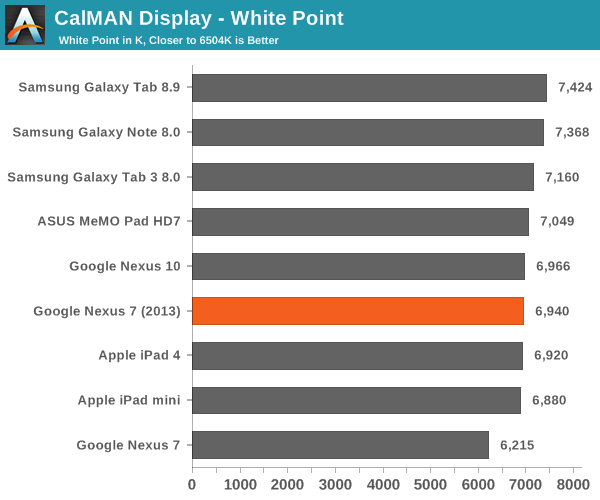
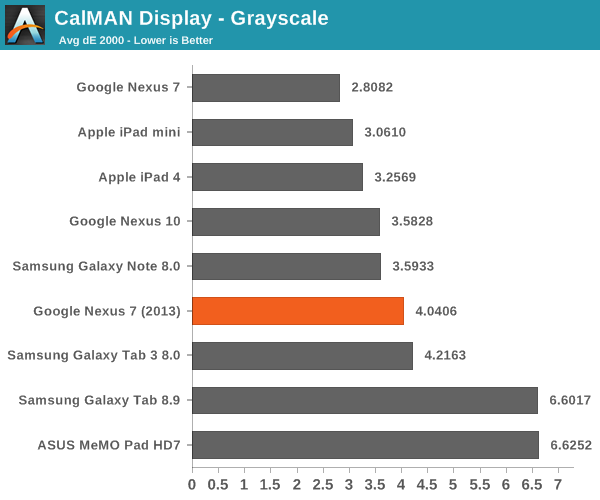
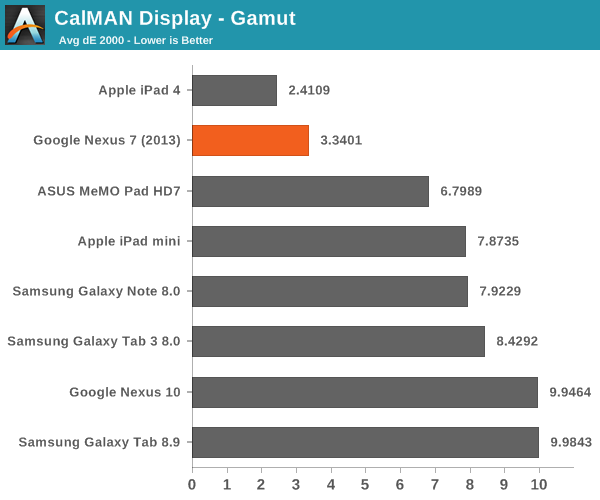
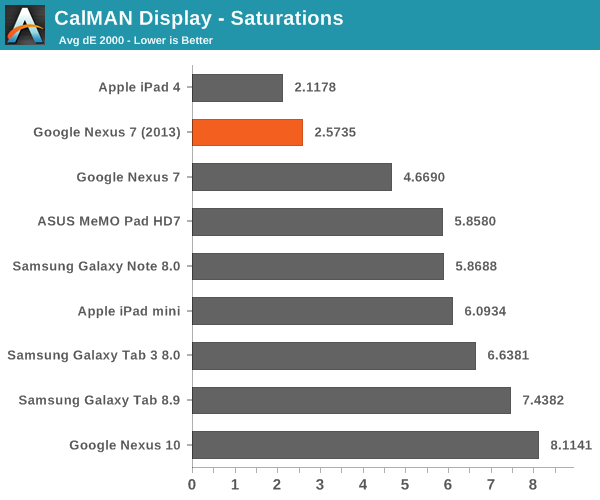
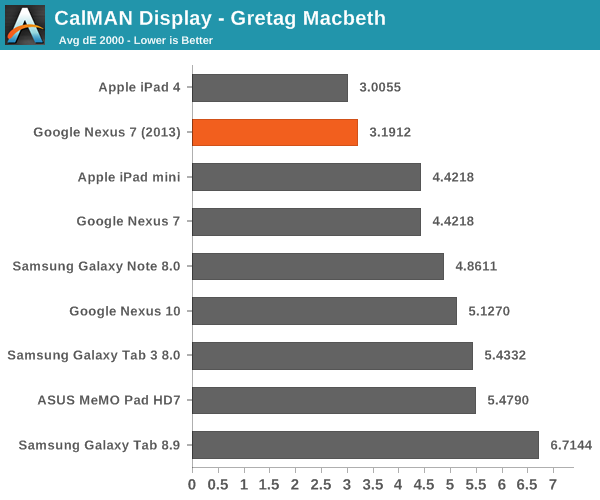
The new panel is also incredibly bright. I typically view 500 nits as the threshold for outdoor usability, and the new Nexus 7 definitely exceeds that threshold. The tablet will drink away all of your battery life if you leave it at this brightness setting indefinitely, but if you need to actually use your tablet outdoors for a while the Nexus 7 works.

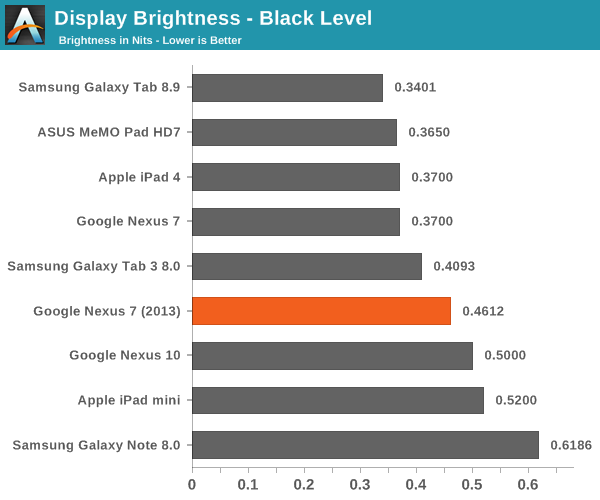
Black levels are a bit higher than on the original Nexus 7, but the resulting peak contrast ratio is still excellent:
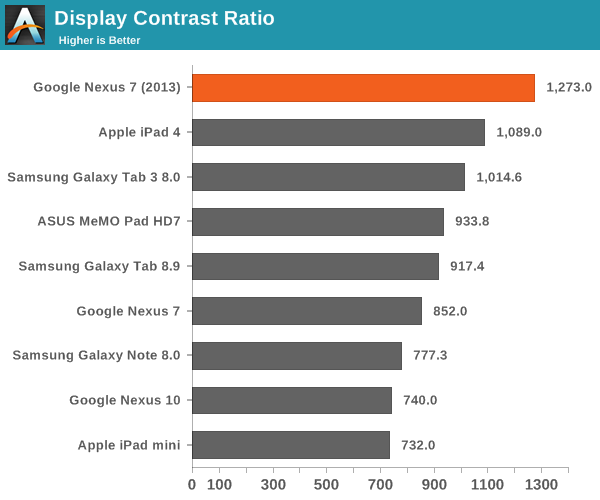
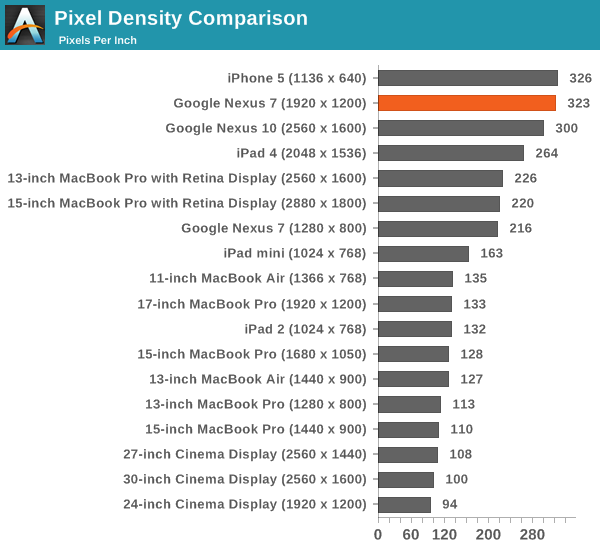
Pixel density shoots through the roof with the new Nexus 7 display as well. Brian was quick to point out that a major advantage of the Android platform is in its flexible resolution handling. The 1920 x 1200 panel presents itself as a 960 x 600 panel to web pages in Chrome, while other apps can use every last pixel for unique content (e.g. games).
The beauty of not having to double the original Nexus 7's resolution but instead settling on an in-between option like 1920 x 1200 is that Google could get away with a performance mainstream SoC instead of something ridiculously high-end.
The display looks great when viewing everything from photos and movies to web pages and eBooks. My only complaint about the Nexus 7's display is its size. A 7-inch tablet is almost pocketable (in fact I did carry it around in my pocket for a day), but the screen can feel a little cramped.


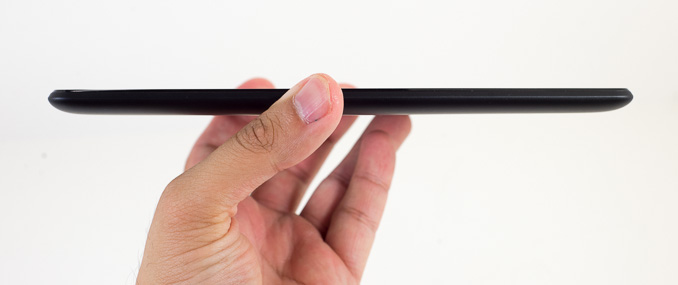
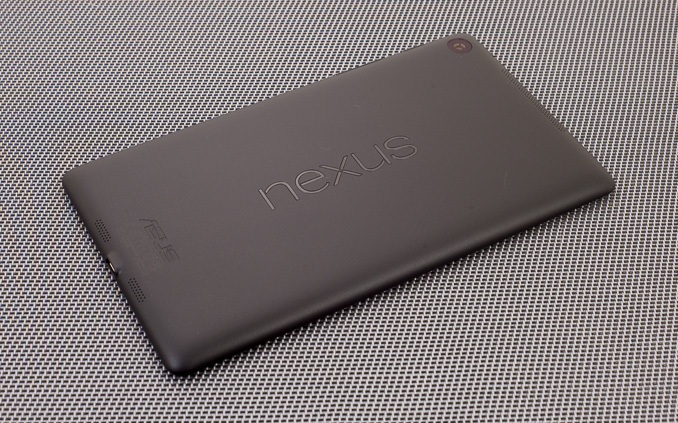
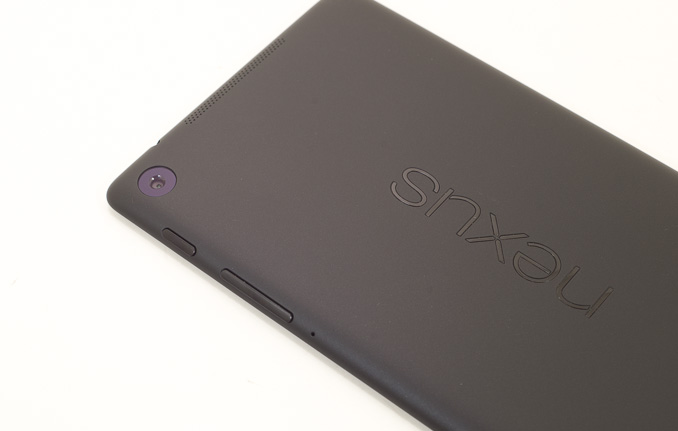


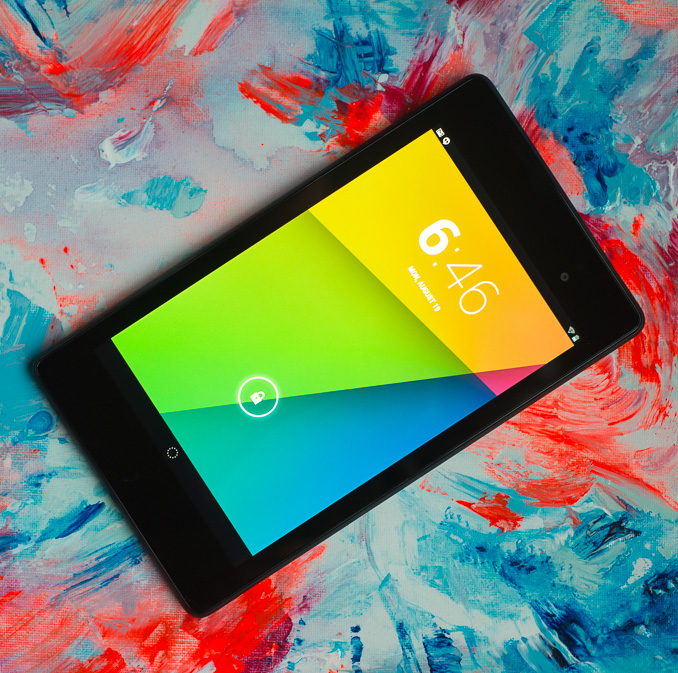
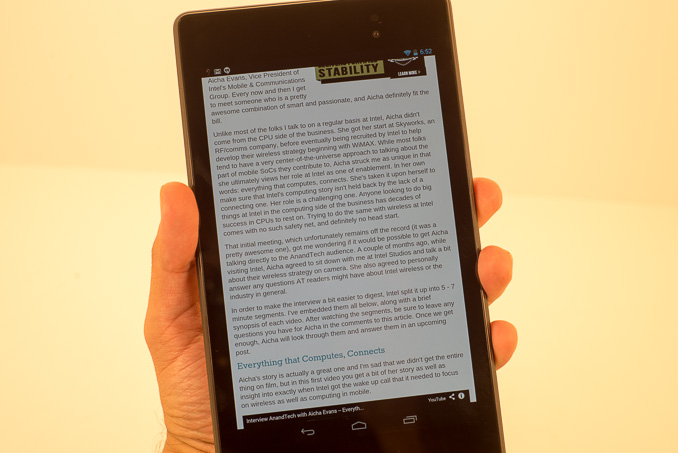
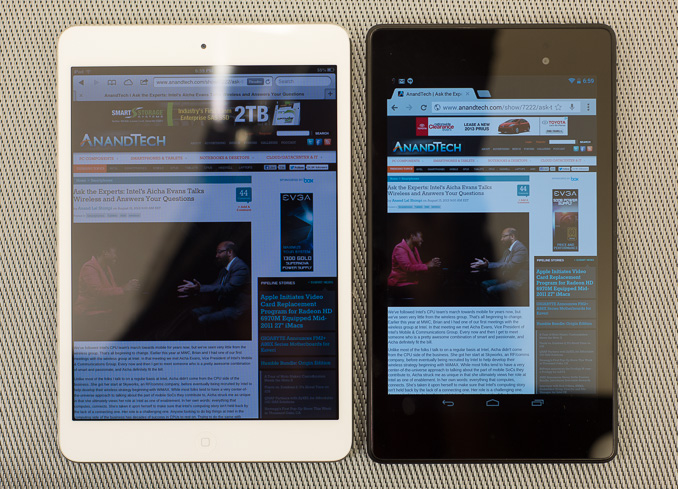








202 Comments
View All Comments
solipsism - Friday, August 23, 2013 - link
1) I use 802.11ac but I haven't turned off g or n, just as I didn't turn off g or b when I used n. By your measure we're still decades away from using 802.11g.2) WAN speeds have nothing to do with LAN speeds. If you understood how WiFi works you'd not male a simple 1:1 comparison.
3) Now you're moving it to a discussion about cellular? These are not mutually exclusive technologies.
joos2000 - Friday, August 23, 2013 - link
In regards to point 2:Most wifi routers are typically hooked to the Internet through xDSL or cable. Typically, when you're surfing or streaming content, it is the dsl/cable connection that is the limiting factor in terms of speed, regardless of what type of wifi you are using. I think that was fairly obvious from the previous guy's post.
However, if you are streaming data from your private server on your gigabit LAN, well, then you may well notice some difference in speed, however, my n-based home wifi can easily stream 1080p content without stuttering, so the new ac standard doesn't feel quite as necessary an upgrade compared from the g->n upgrade I did a while back.
Cheers, /J
solipsism - Friday, August 23, 2013 - link
You either deliberately ignored what I stated or didn't understand it. Your theoretical maximum performance per your LAN or WAN is irrelevant when it comes to the full picture of performance. If you bought an 802.11n router that doesn't mean you get 450 or 600Mbps from that router. Let's say it says 450Mbps on the box and your PC also supports those max data rates, does that mean you're getting 450Mbps right now? Of course not! That's an optimal theoretical level. The farther away you are and/or the more interference affecting Tx or Rx the worse the throughput will be. But for this let's say you are right next to it, and your homes is a Faraday cage. What can you determine in terms of total LAN performance? Nothing should be your answer at this point because you have no data on how many other devices are also using that same WiFi network. For the lack of a better term WiFi works much like the old token ring networks which mean that when the router is Tx or Rx from another device it's not listening to you. This happens quickly but each active device slows down your maximum throughput. This is why, even for a LAN having additional spatial streams, antennas, and higher throughput can affect overall network performance to and from the internet.joos2000 - Friday, August 23, 2013 - link
I'm not saying that you are wrong. I'm just saying that the current tech works well for me (and presumably a lot of people) and that there is no subjective need to fill.If the new standard has improved your experience, since you seem to have a lot of devices on your Wifi, then obviously this generation serves a purpose for you straight away. However, it doesn't for me, for all the reasons you mentioned. And I think that's all the original poster wanted to say really and I agree with him.
whyso - Friday, August 23, 2013 - link
I think what he means and what you aren't getting is that the supplied internet to your house has trouble saturating a 802.11n connection let alone an ac connection. For me with my 5 mbps internet 802.11ac does squat.solipsism - Saturday, August 24, 2013 - link
@ whyso,Of course it doesn't, but that doesn't mean WiFi can help utilize your LAN connection. I have about a few dozen devices on my network with about 10 people connected between wired LAN, main WiFi, and guest WiFi on a single access router so having faster WiFi is quite beneficial to optimizing the WAN connection.
darwinosx - Thursday, August 22, 2013 - link
Completely wrong.jl0329 - Wednesday, October 9, 2013 - link
Dumb shit.ShieTar - Friday, August 23, 2013 - link
"Lack of cellular connectivity on the other hand results in lack of internet access in most locations, and is a major omission."How many people do actually own a second SIM for their tablet instead of just using their phone as a hotspot?
CSMR - Friday, August 23, 2013 - link
People may do this but it should be obvious how terrible this solution is. It requires user intervention, requires the user to carry around a second device and a cable, and it does not give always-on internet but just occasional internet. If this were a good solution you would not need wifi on the tablet either, you could just attach your phone.